How I learned to stop worrying and love working capital
This article is by Ethan Agarwal, founder and CEO of Aaptiv, a digital health company with nearly 200k paying members.
In summer 2017, we had one of those "come-to-Jesus" moments.
We were growing fast, but were burning a ton of cash. We raised a successful Series B in March, and were debating whether to raise another round quickly and keep the pedal to the metal. We had a laser focus on growth which was working, but we were operating the business under the assumption that the economics will work themselves out later.
Johnny Cash: June, that stuff will just work itself out.
June Carter: No, it does not work itself out. People work it out for you and you think it works itself out.
In addition to strong top line growth, we had strong and improving engagement, a world class team, and a first mover advantage that put us far ahead of any other player in the space.
We went out the market to raise a Series C, and showed them what we had done.
The result?
This is the story of what we did to go from burning $2.4m a month to being free cash flow positive in 7 months.
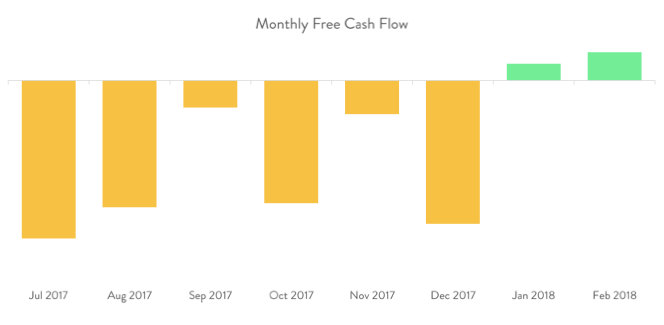
Since the beginning, we had been chasing one thing - growth - as fast as possible, with cost considerations getting minimal focus. That made sense as we fought to establish traction. We needed as many people to know about us as possible, and that meant spending more advertising dollars. And it worked. From January 2016 through July 2017, we grew at a 24% CMGR over 19 months. (Go ahead, green highlight that. I'll wait.)
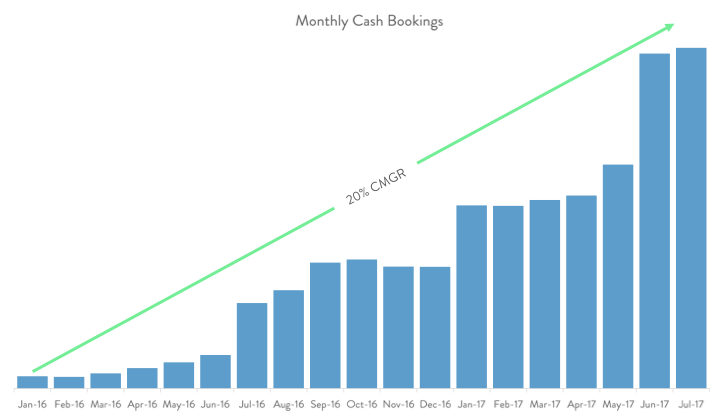
We raised over $30m in venture capital along the way. This "success" resulted in our cash balance not being an input into my day to day decision making. After all, the strategy was obvious - throw fuel on the fire and get Aaptiv in front of as many people as possible.
Suddenly, in July 2017, we burned $2.4m. I learned that shockingly, my brilliant strategy of ignoring the cash balance wasn't magically making us more cash.
When we went out to raise our next round, the market responded decisively. They simply would not support our strategy of high burn + high growth, regardless of how our other KPIs were performing. (Another company suffering a similar fate was Blue Apron. The company had a novel solution to a common problem, great branding, and a first mover advantage. They grew from $70m revenue in 2014 to $700m in 2016. Unfortunately, due to their high burn, the IPO was not particularly successful, cutting shares in half in two months.)
This was incredibly frustrating at the time. After all, we had grown immensely, and that too in a hyper competitive market ("You want to start a fitness company? Consumer focused? Audio? Are you drunk?") that no one thought we could penetrate. We proved everyone wrong; we had over a hundred thousand members paying $10/month.
As it turns out though, the market was right. The market is always right. That's why the market always wins.

The truth is, it doesn't matter how you define "right". If you hear the same thing from every investor, then that is "right." (If you disagree, your options are either to change what you define as right, or shift your business in such a way that you no longer need to tap the capital markets.)
So the market told use we were wrong. We had to reduce burn if we had a chance of survival. What now? Traditionally, there are two avenues for consumer subscription businesses to reduce burn.
- Layoffs, which are horrific all around.
- Slow down acquisition spend, which will slow down growth.
We definitely didn't want to do the first. We debated doing the second. But what we realized was there was a third secret path that almost no one was talking about.
3. Fix the working capital ratio.
Subscription businesses have a fascinating model. We pay money up front to acquire a member, and then we receive proceeds (hopefully multiples of that acquisition cost) over that member's lifetime. It's quite simply, a working capital business. A similar parallel is insurance companies, which are ultimately asset managers, investing float earned from premiums paid prior to having to pay out a claim often decades later.
The ratio of how much we earn over time (the lifetime value of a member) relative to how much we spent up front to acquire a member (the customer acquisition cost) is called the LTV/CAC ratio. Traditionally, mature, public company subscription businesses operate between 3-5x. High growth startups play between 1-3x. In theory, in a world of zero cost of capital, unlimited liquidity, and an infinite market size, any LTV/CAC greater than 0 is perfectly acceptable. But of course, none of those three things are true. Capital always has a cost; liquidity, though abundant, isn't unlimited; and market sizes are never infinite.
In July 2017, our LTV/CAC was sitting at 0.9x. Though it was greater than 0, when accounting for the three aforementioned economic realities, we realized that our cash burn problem was really just a working capital problem.
To improve our working capital, we had to both increase the lifetime value of the members, and most importantly, receive that money earlier.
There are three ways to increase lifetime value.
- Pricing
- Packaging
- Product
Making product improvements that make your members actually stick around longer is a ton of fun and where most businesses focus exclusively. Pricing and packaging are less commonly prioritized or understood, but are equally important and just as fun. For the sake of this article, I'm focusing only on our efforts within these two.
Before we discuss our work, it's important to align on one fact: when we talk about LTV/CAC, we're actually talking about CLTV/CAC, or Contribution LTV. CLTV is the measure of lifetime value that strips out COGS from the gross revenue earned by a subscriber. So if I reduce COGS, I've increased the CLTV. Around here, CLTV/CAC rules everything around me.
We looked at our COGS and focused on our biggest expense - the 30% merchant fee that we were required to pay Apple and Google as part of their in-app purchase protocol. If we could sell Aaptiv memberships on our websiteinstead of through IAP, we would effectively eliminate this expense. (Manyother businesses have struggled with this challenge, and found some creative solutions.)
When we conducted analysis into the behavior of our existing web members, we discovered a few additional benefits: first, they had higher engagement, which meant higher retention, which in turn meant higher CLTV; second, they were twice as likely to convert from a free trial into a paying member.(Crucially, we are only talking about purchasing a membership through our website. No one takes our classes on our website. The mobile apps are the only way to take classes.) So woohoo, let's get everyone to purchase their membership through the web!
While this would solve the problem of increasing the CLTV, it wouldn't solve the problem of earning the money earlier. In order to do that, we would need to make one other important strategic shift; away from monthly plans paid over time to annual plans paid up front.
The objective was clear: we needed to sell annual memberships on the web.
Here was the problem: in July 2017, 1% of our new members were choosing annual memberships, 8% of our revenue was through web, and only 0.2% subscriptions were both. A full 87% was on a monthly plan and had signed up through the App Store - the worst CLTV bucket. I started to worry - how long would such a dramatic transition take? This felt like something that could take years, and we simply didn't have years to get this right.
Clearly, significant work was needed. We embarked on an ambitious agenda.
First, to drive traffic to the web, we built out a full engineering team that would focus exclusively on our web transition. We revamped our web product and shifted our marketing dollars to drive traffic there. We made the website an exciting place to be with highly relevant content that covers a broad series of heath and fitness topics. We A/B tested dozens of iterations of the home page, sign-up forms, and check out flows. At the start, this transition didn't go smoothly - we had to stomach higher acquisition costs as we were less experienced with this new approach. But we were patient (stubborn?) and kept iterating.
Ultimately, the strategy worked. In July 2017, 4% of new subscribers were signing up on web; In January 2018, that figure was over 40%.
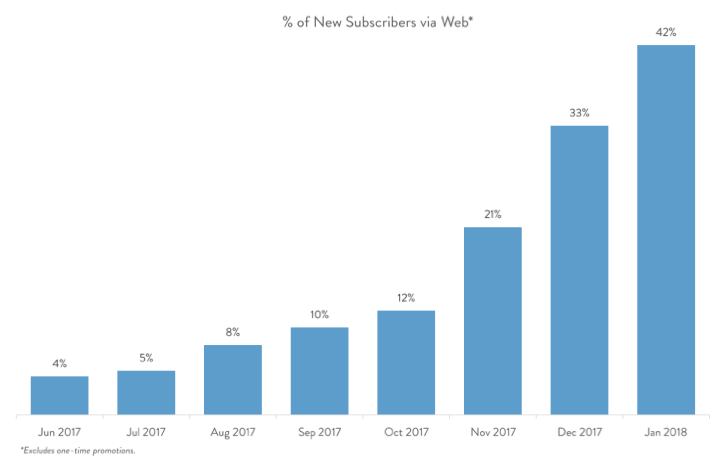
Second, in order to shift folks to the annual plan, we implemented a thorough price testing exercise. One thing that was critical for us was to not try to swindle or cheat the members in any way. As part of the quantitative effort, we also conducted a considerable amount of qualitative research in speaking to current and potential members about the type of pricing they would prefer. Fortunately for us, the content space we live in, wellness, naturally lends itself to longer memberships. The nature of wellness is that it is a journey - it doesn't happen in a month, or even a year. The outcome of the price testing and member conversations resulted in three key changes:
- We went from no trial on the annual plan to a 30 day trial
- We removed the 7 day free trial from the monthly plan
- We increased the price of the monthly plan from $10 to $15
Those three changes resulted in the shift seen below:
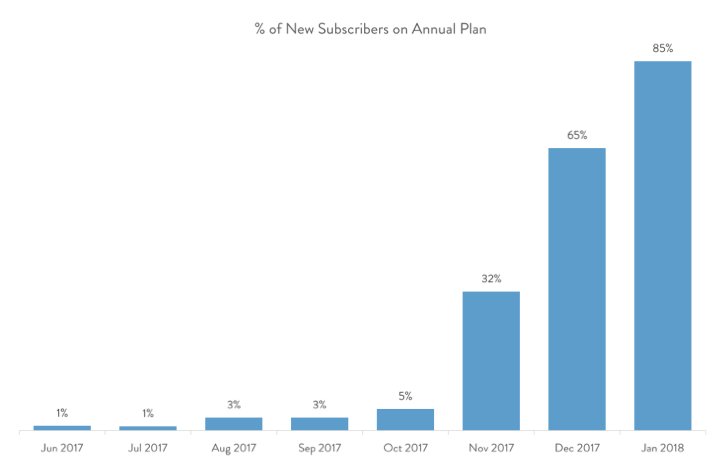
Crucially, after implementation, the message from consumers was clear: they preferred this option too.
While we were proud of the successful shift to annual and web plans, we realized another key working capital opportunity. For revenue generated from the App Store, we were receiving the proceeds up to two months after the transaction. A member purchasing an annual plan on Jan 15th for $100 meant we received $70 on March 7th. (For web transactions, this isn't a problem as the proceeds are received 48 hours later.) While we had successfully shifted much of our new traffic to web, a considerable amount of our revenue was still being generated from the App Store, so we needed to find a solution to this problem.
My CFO and I worked to set up accounts receivable financing for our iOS receivable. We worked with a bank to provide us access to the capital we were going to receive anyway, just earlier, in exchange for a low interest rate. Since the debtor is Apple, the bank saw very low lending risk. In the example above, we would receive the proceeds on Feb 1st, a full 37 days earlier. Concurrently, we also negotiated better payment terms with our advertising vendors.
The combination of all of our efforts resulted in our CLTV increased 155% from June 2017 to January 2018.
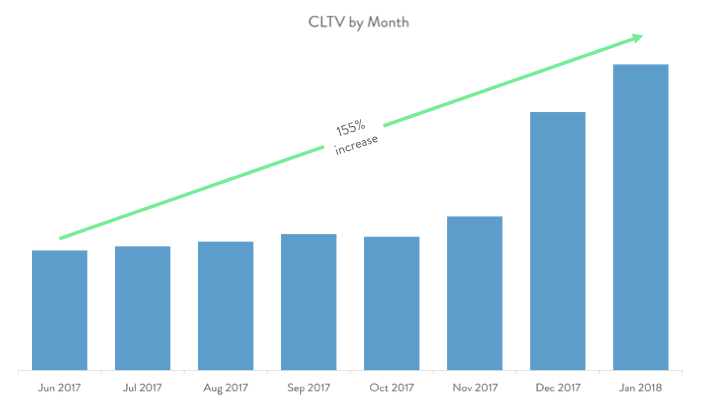
In my conversations with other startup CEOs and investors, the topic of working capital almost never comes up. Most startups don't see the importance, but that couldn't be further from the truth. After all, as CEOs, we are simply investors, investing capital and resources (our team's skills), and expecting a return. Managing these resources is crucial for success. (Excellent read on this very topic.)
We had always been operating off the assumption that in order to grow faster, we need to spend more money. In mid-2017, we asked ourselves - what if we could grow faster by making more money? With this series of pivots, we oversaw a dramatic shift in the company's business model - the outcome is that we now have a negative payback period. No, the more money we make, the faster we grow.

This was a gargantuan task undertaken by the Aaptiv team. I cannot believe (but really, I can) that we accomplished this seismic shift in such a short term. Importantly, I am most thankful that this rapid transition to free cash flow did not require layoffs. Rather than overreacting and cutting team members as a knee-jerk overreaction to market criticism, we considered more sophisticated capital management opportunities, which I can say with confidence, saved the company and has now put us on a path of never needing to raise external capital, except at our option.
source: Medium